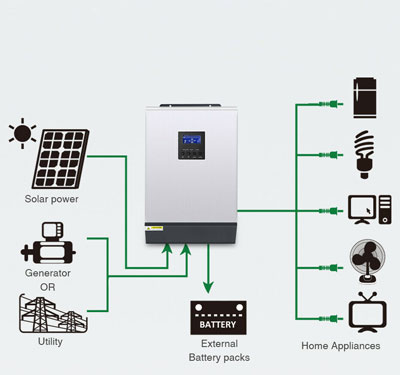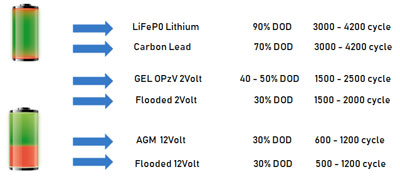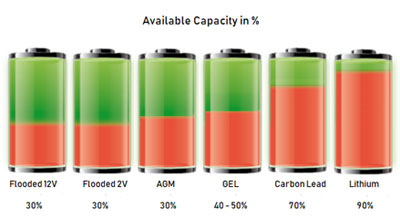
OFF GRID SOLAR SYSTEM - STAND ALONE SOLAR - REMOTE POWER
Off-Grid power is not so different from the normal grid connection except from the batteries.
Modern Off-Grid inverters like our Maximo Inverter Chargers supply Pure Sine Wave power that is superior in its wave form to what comes from the big Power Stations.
In the early days of Off-Grid power people could only afford small inverters and even smaller batteries. So the early users of Off-Grid power had to live without many modern appliances.
Times have changed and inverters like the Maximo inverters have made it possible to have these modern appliances and even air conditioners, dish washers, cloth dryers and Electric Hot Water systems.
There are three main issues to consider with Off-Grid systems that need to be carefully considered.
Issue one is the Peak Power Demand measured in Kilowatt or kw. How many electrical appliances / loads will you run at the same time.
There are controlled loads and uncontrolled loads. Controlled loads are appliances that somebody needs to switch on or off, so you have control of it.
Uncontrolled loads are usually automatic appliances, like water pumps, fridges, freezers, etc.
To find the right size for your system you need to add up all the appliances you will run at the same time plus the uncontrolled loads.
This will determine the size of your system. Each Maximo PV5048 HM inverter can supply 4kw of power.
Two or three inverters connected ( we call it paralleled ) can continuously supply 8kw or 12kw respectively.
A normal grid connected house has about 15kw of electrical peak power connected.
 Issue two is how long will all these appliances / loads run every day, this is measured in Kilowatt Hours or kwh. This will determine the size of your battery bank.
If you had a grid connection before it is reasonable to think that your average power bill will show how much power you will use when you go Off-Grid.
Locking at a normal power bill, most households are using between 15kwh and 20kwh per day. The size of the battery is determine by the amount of power you are using when the sun doesn’t shine.
And we find that this is the hardest question to answer. We recommend to have a battery capacity of at least 8kwh of available power.
Issue two is how long will all these appliances / loads run every day, this is measured in Kilowatt Hours or kwh. This will determine the size of your battery bank.
If you had a grid connection before it is reasonable to think that your average power bill will show how much power you will use when you go Off-Grid.
Locking at a normal power bill, most households are using between 15kwh and 20kwh per day. The size of the battery is determine by the amount of power you are using when the sun doesn’t shine.
And we find that this is the hardest question to answer. We recommend to have a battery capacity of at least 8kwh of available power.
The Maximo Inverter Chargers have an automatic generator start function build-in. If the batteries get low the inverter can tell the generator to start up and stop at user defined voltage points, to keep the batteries happy.
We have a saying “ Happy batteries, happy wife. Happy wife, happy life “.
In the olden early days of Off-Grid living, battery banks were designed to hold at least two or three days of reserve power. Many older style Off-Grid inverters still work to this principal. The Maximo Inverter Chargers require a smaller battery bank because of two things. First each inverter can take up to 4.8kw of solar panels, with a daily power production of an average of 20kwh per day. And secondly because of the being able to take a cheap generator to charge up the batteries in case of cloudy days.
Issue three is the size of the solar array. How many solar panels are required to fulfil your power needs.
We recommend to connect 12 solar panels of about 315W each to each of the Maximo inverters. With one inverter this would be about 3.8kw.
Considering that the average power production would be about 16kwh per day. Winter production would only be about 10kwh per day and in summer production would be about 22kwh per day per inverter.
Under normal weather condition batteries will be recharged in the morning after about 3 to 4 hours of sunshine.
Choosing the right battery can be confusing, but this might help.
 DOD, capacity, cycle live, C10, C100, Ah, temperature compensation, Flooded, AGM, GEL, Lead Carbon, etc.????
DOD, capacity, cycle live, C10, C100, Ah, temperature compensation, Flooded, AGM, GEL, Lead Carbon, etc.????
First we need to sort out C10 and C100.
C10 indicates the battery capacity over a 10 hour period.
C100 indicates the battery capacity over a 100 hour period.
A battery cycle is defined by the battery being fully charged and being discharged to its DOD level.
In solar systems we usually cycle batteries over night so C10 would be more appropriate to be used.
We do not cycle batteries over 100 hours or 4 days.
Cycle life comparison table
 Flooded 12Volt batterie might only last 3 years, where Lead Carbon batteries might last 12 years.
Flooded 12Volt batterie might only last 3 years, where Lead Carbon batteries might last 12 years.
We have competitors that advertise battery capacity in C100 Ah’s.
A battery that has 790Ah at C100 usually only has 600Ah at C10, a 30% reduction.
But that 600Ah battery can not supply 600Ah, depending on the type of battery it might only be able to give you 30% or 180Ah of it.
Different battery types have different characteristics.
 DOD means Depth of discharge, or usable energy without harming the battery.
DOD means Depth of discharge, or usable energy without harming the battery.
A Flooded 2Volt or 12Volt or AGM battery can only give 30% of its capacity without dropping its cycle life considerable.
A GEL battery might give 50%, where a Lead Carbon battery can give 70% and a Lithium battery can give up to 90% of its total capacity.
A 600Ah battery with a DOD of 30% only has a usable capacity of 180Ah’s.
A 600Ah battery with a DOD of 40% only has a usable capacity of 240Ah’s
A 600Ah battery with a DOD of 70% only has a usable capacity of 420Ah’s.
A 48Volt battery bank with 180Ah of usable energy has 8.64kwh of available power.
A 48Volt battery bank with 240Ah of usable energy has 11.5kwh of available power.
A 48Volt battery bank with 420Ah of usable energy has 20.1kwh of available power.
 Cost example.
Cost example.
A 48Volt GEL battery bank with a 600Ah C10 has a useable capacity of 240Ah or 11.5kwh, cost you $14,000.
A 48Volt Lead Carbon battery bank with a 500Ah C10 has a useable capacity of 350Ah or 16.8kwh, cost you $14,000.
A 48Volt Lithium battery bank with 20kwh capacity will cost also around $15,000.
Currently most inverters, off-grid or grid connect can not work with Lithium batteries.
With an expected life of 12 years compared to 7 years for GEL batteries.
Lead Carbon batteries, an Australian CSIRO invention, are the pick of the pack, for off-grid systems.
How to Reach?
Feel free to call us, we will be very happy to assist you.
Maximo Power Inverters
101 Barrons Road, Kingaroy, Qld, 4610
ABN 94 140 540 889
Email:
Phone:
Reach out to us. We'd Love to hear from you
To request for quotation, please complete the form and our sales team will get back to you shortly.